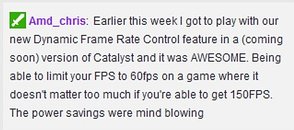- Joined
- Oct 9, 2007
- Messages
- 47,878 (7.38/day)
- Location
- Dublin, Ireland
| System Name | RBMK-1000 |
|---|---|
| Processor | AMD Ryzen 7 5700G |
| Motherboard | Gigabyte B550 AORUS Elite V2 |
| Cooling | DeepCool Gammax L240 V2 |
| Memory | 2x 16GB DDR4-3200 |
| Video Card(s) | Galax RTX 4070 Ti EX |
| Storage | Samsung 990 1TB |
| Display(s) | BenQ 1440p 60 Hz 27-inch |
| Case | Corsair Carbide 100R |
| Audio Device(s) | ASUS SupremeFX S1220A |
| Power Supply | Cooler Master MWE Gold 650W |
| Mouse | ASUS ROG Strix Impact |
| Keyboard | Gamdias Hermes E2 |
| Software | Windows 11 Pro |
AMD is working on a new software feature for its Radeon graphics cards, which it calls "Dynamic Frame Rate Control." Revealed informally to the web, by AMD director of PR Chris Hook, who goes by the handle "AMD_Chris" on various forums, Dynamic Frame Rate Control, or DFRC, is a frame-rate limiter, which gives you power savings when you reduce frame-rates. This probably works by reducing clock speeds to achieve the desired frame-rates.
Sounds a lot like V-Sync? Well the way AMD describes it, DFRC is a frame-rate limiter with a slider. Whereas V-Sync makes the GPU spit out frame-rates to match the monitor's refresh-rate. When a game runs, say, 100 FPS, and you enable V-Sync to bring that down to 60 FPS, your GPU is still running at 3D-performance clocks, unless the 3D load is way too low, and the driver decides to change the power state altogether. DFRC probably achieves lower frame-rates by underclocking the GPU, and increasing the clocks, whenever the scene gets more demanding, and the output FPS drops below the target. Hook describes the energy savings with DFRC as "mind blowing." This peaks our curiosity.

View at TechPowerUp Main Site
Sounds a lot like V-Sync? Well the way AMD describes it, DFRC is a frame-rate limiter with a slider. Whereas V-Sync makes the GPU spit out frame-rates to match the monitor's refresh-rate. When a game runs, say, 100 FPS, and you enable V-Sync to bring that down to 60 FPS, your GPU is still running at 3D-performance clocks, unless the 3D load is way too low, and the driver decides to change the power state altogether. DFRC probably achieves lower frame-rates by underclocking the GPU, and increasing the clocks, whenever the scene gets more demanding, and the output FPS drops below the target. Hook describes the energy savings with DFRC as "mind blowing." This peaks our curiosity.

View at TechPowerUp Main Site


 50W figures while gaming but if this can slash 10% or so it would be a welcomed improvement. I guess it'll launch along the Hawaii refresh?
50W figures while gaming but if this can slash 10% or so it would be a welcomed improvement. I guess it'll launch along the Hawaii refresh?



 Waiting for these new babies. Allegedly, 20 nm at GF.
Waiting for these new babies. Allegedly, 20 nm at GF. 


